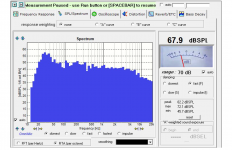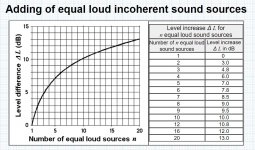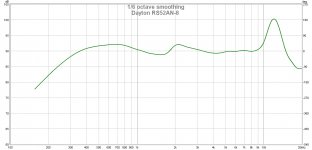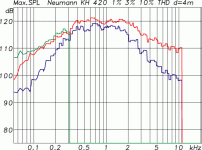Those closeup photos are definitely renders.. in the last photo you can tell that the woofers are carbon fibre and the midwoofers are glossy
If you want to play loud you certainly do, or be prepared to exchange tweeters all the time. Apart from that, how do you get directivity right with only the 8"'s and the tweeter? That is, if directivity was of concern when Mischa designed this.From that photo with scale...
Dayton RSS390/Seas CA22/RS52AN (blech!)/SS D3004-6600
He really does NOT need the mid-dome with those other drivers.
So many of these big speakers claim average SPL of over 120 dB. Just can't find a dome midrange or tweeter that can take the hit. The Volt 3" dome midrange can hit average SPL of 110 or 113 dB, depending on how you calculate... even two of them can't hit the 126 dB claimed by this Dynaudio...


Apart from that: This Dynaudio has 5" cone mids and not domes.
They aren't very efficient but can take almost 300 watts long term. But if you use wideband noise for measuring active multiway speakers one can get quite high SPLs.
Regards
Charles
They aren't very efficient but can take almost 300 watts long term. But if you use wideband noise for measuring active multiway speakers one can get quite high SPLs.
Regards
Charles
But if you use wideband noise for measuring active multiway speakers one can get quite high SPLs.
Yes this. If a 3 way speaker system can play 120 dB of pink noise, it does not mean that any individual driver can play 120 dB at a particular frequency.
Example: This is pink noise, with an overall SPL of 67.9 dB. Notice that at any given frequency, the sound level is much lower. If I opened up the resolution bandwidth from 1/6 octave to something wider, like 1 octave, the RTA spectrogram levels would rise, but they would never get close to 67.9 dB for any given frequency band.
Attachments
I think the SPL measured with wideband pink is closely the same to any given single frequency's SPL capability.......
that is, until thermal compression kicks in, or xmax limitations are hit, or THD goes through the roof....or perhaps more simply said, until linearity falls apart.
But the point i'm trying to make, is that max SPL measured with pink across a driver's bandwidth, will pretty much match sine sweep SPL when playing at less than war volume.
@ markbakk, great question 🙂
For me average SPL = Equivalent Sound Level (Leq) measurements, using flat Z weighting, for whatever length of time desired. (LZeq in REW)
I've found 1 min works great for sensitivity measurements, or for any SPL levels short of linearity breakups.
that is, until thermal compression kicks in, or xmax limitations are hit, or THD goes through the roof....or perhaps more simply said, until linearity falls apart.
But the point i'm trying to make, is that max SPL measured with pink across a driver's bandwidth, will pretty much match sine sweep SPL when playing at less than war volume.
@ markbakk, great question 🙂
For me average SPL = Equivalent Sound Level (Leq) measurements, using flat Z weighting, for whatever length of time desired. (LZeq in REW)
I've found 1 min works great for sensitivity measurements, or for any SPL levels short of linearity breakups.
I think the SPL measured with wideband pink is closely the same to any given single frequency's SPL capability.......
that is, until thermal compression kicks in, or xmax limitations are hit, or THD goes through the roof....or perhaps more simply said, until linearity falls apart.
Yes that makes sense to me. Would you agree that in a 3 way system with 3 drivers, it would be possible for the whole system to be capable of 110 dB of pink noise without having any individual driver be capable of 110 dB by itself?
Yes that makes sense to me. Would you agree that in a 3 way system with 3 drivers, it would be possible for the whole system to be capable of 110 dB of pink noise without having any individual driver be capable of 110 dB by itself?
Yes i would agree. My understanding is that if the three sections have equal SPL capability, their summation of incoherent pink noise should add +4.8dB.
Got this chart from Total dB level adding of incoherent or noncoherent uncorrelated sound sources signals combine sound levels two sources resultant level audio logarithmic decibel scale decibels or SPL sound pressure level add signal noise levels noncoherent incoherent
Attachments
re:'RS52AN (blech!)" - why?
I have never liked the sound of the RS52AN; since it's inception. I also loathe the sound of the Vifa DQ25 and Seas L18, so there you have it!
Plus- QC is no longer as good on the typically loved RS52AN. This is a screen-shot from Jon Marsh over at htguide of a recently measured sample or 3. Performance is matching on all of the newer units, and the older one he has still looks a lot better as they used to.
So- It's not only my opinion any longer, but proven that they are not worth the cost of admission.
Later,
Wolf
Attachments
Genelec 1236A:
SPL
Peak SPL
≥136 dB
Maximum peak acoustic output per pair in a listening room with music material at 2 m.
Short term max SPL
≥130 dB
Maximum short term sine wave acoustic output on axis in half space, averaged from 100 Hz to 3 kHz at 1 m.
Long term max SPL
≥125 dB
Maximum long term RMS acoustic output in the same conditions with IEC weighted noise (limited by driver protection circuit) at 1 m.
1236A - Genelec.com
SPL
Peak SPL
≥136 dB
Maximum peak acoustic output per pair in a listening room with music material at 2 m.
Short term max SPL
≥130 dB
Maximum short term sine wave acoustic output on axis in half space, averaged from 100 Hz to 3 kHz at 1 m.
Long term max SPL
≥125 dB
Maximum long term RMS acoustic output in the same conditions with IEC weighted noise (limited by driver protection circuit) at 1 m.
1236A - Genelec.com
- Home
- Loudspeakers
- Multi-Way
- Decode this large format studio monitor...



